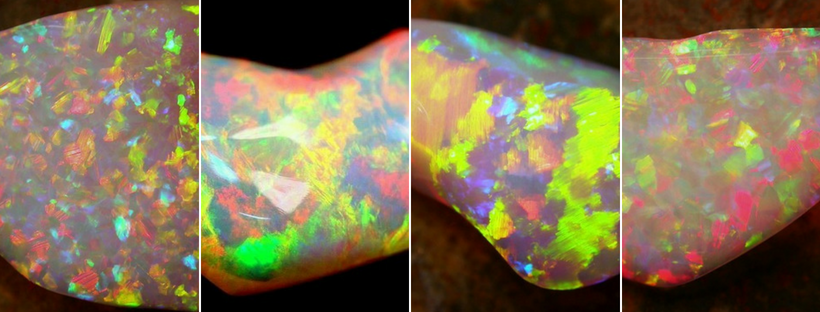
Informationen über brasilianischen Opal
Brasilianischer Opal wird im Nordosten des Bundesstaates Piauá abgebaut. Dort gibt es keine großen Opalvorkommen, und als einziges Gerät wird ein Generator verwendet. Viele brasilianische Opale stammen aus einem Steinbruch am Fuße einer Sandsteinklippe und werden von Hand abgebaut.
Brasilien produziert wunderschöne Kristallopale mit ungewöhnlichen, pastellfarbenen Feuertönen. Aufgrund seines im Vergleich zu anderen Opalen geringen Feuchtigkeitsgehalts ist er ein robuster Opal.

Eine der wichtigsten Minen ist Boi Morto, wo Opal hauptsächlich in den Tonschichten vorkommt.
Brasilianischer Opal ist meist weiß, halbdurchsichtig bis hin zu einem durchscheinenden Körper. Vor einigen Jahrzehnten wurde in einer Ader in Boi Morto eine kleine Menge schwarzer Opal gefunden. Der größte jemals in Brasilien gefundene Opal wog erstaunliche 4,3 kg.
Wie entsteht brasilianischer Opal?
Brasilianischer Opal bildet sich in Adern oder Schichten aus Opalen und in alluvialen Ablagerungen, die über Jahrhunderte von Flüssen angeschwemmt oder an Hängen zwischen Quellgebiet und heutigem Flussbett abgebaut wurden. Australischer Opal bildet sich als Knollen oder in Adern, brasilianischer Opal hingegen entstand auf andere Weise in vorwiegend aus Sandstein und Schluffsteinen bestehenden Gesteinen.

Wo findet man brasilianischen Opal?
Einer unserer verifizierten Verkäufer besitzt eine Opalmine in der Region Horca in Brasilien.
Marc von Opalbrazil bietet wunderschöne natürliche Opale aus seiner Opalmine in der Horca-Region Brasiliens an.
Im Vergleich zu den australischen Wüstenbedingungen bietet sich hier eine ganz andere Landschaft; die grüne Vegetation und die vielen Wassermassen stehen in völligem Gegensatz zu den trockenen, staubigen Bedingungen des australischen Outbacks.
Brasilianische Opale sind an sich einzigartig und ganz anders als australische oder äthiopische Opale.
Leider ist die Produktion gering, sodass nicht viel Geld für die Vermarktung brasilianischer Opale ausgegeben wird, weshalb viele Opalkäufer die atemberaubenden Kristallopale aus Brasilien nicht kennen.
Ende der 1980er Jahre stieß diese Mine auf ein riesiges Opalvorkommen, aber seither ist es schwieriger geworden, gute Opale zu finden.
In den letzten Jahren wurde im Bundesstaat Piauí im Nordosten Brasiliens ein bedeutendes Vorkommen an wertvollem Opal entdeckt. Dieser bedeutende Opalfund befindet sich in der Gegend um die Stadt Pedro Secundo (Pedro II). Jobbins analysierte diese Lagerstätten im Auftrag der brasilianischen Regierung und stellte aufgrund seiner Ergebnisse Folgendes fest:
-Bei einigen brasilianischen Lagerstätten befindet sich der Opal aufgrund der Anordnung von Adern und Schichten in der Nähe von Sandsteinschichten oder im Boden, wo er sortiert wird.
Diese Ablagerungen wurden im Boden oder in verwitterten Konturen direkt hinter der Quelle entdeckt und haben keine Fantasie angeregt.
Diese Ablagerungen befinden sich üblicherweise auf einem Hügel im Tal zwischen der Quelle und dem nahegelegenen Flusstal.

Opale aus aller Welt enthalten üblicherweise nur 5–6 % Wasser, im Vergleich zu Opalen aus anderen Regionen mit einem Wassergehalt von 10–12 %. Dies ist von Bedeutung, da brasilianische Opale weniger anfällig für Risse durch Hitze oder Sonnenlicht sind. Zudem gelten sie als etwas härter als andere Opale.

Kaufen Sie brasilianischen Opal
Suche nach Opal Encyclopedia
Verwandte Auktionen
In Verbindung stehende Artikel
Der Boulder-Opal zählt zu den wertvollsten und am meisten unterschätzten Opalen auf dem Markt. Erfahren Sie mehr über diesen einzigartigen Opal und entdecken Sie die wunderschönen Steine in unserem Angebot.
29th May 2019
Wayne und Estella Sedawie gründeten vor über 14 Jahren Opal Plus, angetrieben von ihrer Leidenschaft für Opale, und haben das Internet als wertvolles Werkzeug entdeckt. Über dieses Internet werden die meisten internationalen Transaktionen des Unternehmens abgewickelt.
17th Oct 2018
Der Geburtsstein für Oktober ist unser Lieblingsedelstein, der Opal. Ob schwarzer Opal, mexikanischer Opal oder äthiopischer Opal – jeder einzelne ist so einzigartig wie die im Oktober Geborenen.
3rd Oct 2019
Neue Artikel
Schwarze Opale sind die begehrteste Opalart. Ihre tiefe Basis erzeugt ein regenbogenfarbenes Farbenspiel an der Oberfläche. Entdecken Sie die Verwendung, Eigenschaften, Geschichte und den Wert schwarzer Opale!
7th Dec 2025
Erfahren Sie, wie Opale bewertet werden und welche Faktoren ihren Preis beeinflussen. Von Farbe und Leuchtkraft bis hin zu Schliff und Herkunft – lernen Sie, wie die verschiedenen Opalarten bewertet werden, inklusive Preisbeispielen.
19th Jul 2023
Begeben Sie sich auf eine Reise und erfahren Sie von unserer Gastautorin Vivien Schapera von Crystal Healing Techniques mehr über die Heilkraft von Opalen!
20th May 2023
Artikelkategorien
All there is to know about Opals including Black Opals, Ethiopian Opals & Boulder Opal
14 Artikel
Check out our fascinating information and articles on all things amazing in the Opal world
41 Artikel
Opal Auctions sellers who are approved as opal Verified Sellers
4 Artikel





